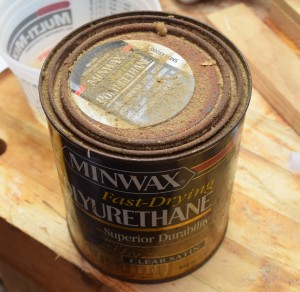I never intended to do any reviews when I made this blog, but I have picked up a few things recently that I feel warrant some ranting and raving. This is only half of that. I have been moving away from new finishes like polyurethane, and towards older finishes like tung oil and shellac. The problem is some of them spoil easily if not stored properly. That is where stop loss bags come in. You can fill them up and push all the air out every time you use them.
Filling is a bit of a problem though, they don’t stand up on their own when empty, and are pretty floppy even once filled. Buying the bags gets you free plans for a funnel and turkey baster stand. To fill, you push this tubing thing on your bag and a funnel and sit in the stand.
The filling is fine, but I am honestly going to use this thing a few times a year at best. I hate having a thing around that rarely gets used and takes up space. Instead I took a small funnel and screwed the holding tab into a board.
I clamped the board in my front vise and adjusted the height until the bag was at a good level. This worked out really well. Any board will do, and you can throw it back on the scrap pile when done. Don’t bother with the jig, do this.
Off we were to the races until the bag started to slip off. It turns out the clear tube should go over the bag, and the red part should go over the funnel. Oops! The picture below is the proper setup.

Getting the air out involves an awkward squeeze and screw on of the top. It does stand up reasonably well once past about half full, and pouring has been easy. I went into my boiled linseed oil bag twice so far and both times I found it easy to do a controlled pour. Time will tell if these are a keeper or not. Over all I find them a little finicky, but worth the effort. They help me get rid of rotten rusty cans like this one, and stack nicely in my finishing cabinet.


Conclusion:
Filling is a bit finicky, but very doable with help of a single board. Long term storage remains to be seen, but he principle seems sound. Labeling is easy. Pouring is a big bonus that I hadn’t thought about. I hate pouring out of cans, you always gunk up the rim. Even the big upright tins get the finish all over the threads. The difficulty of pouring finish back in is also kind of a feature, you shouldn’t be doing it. I want to start using a lot more tung oil and varnish, and this should facilitate!

















































